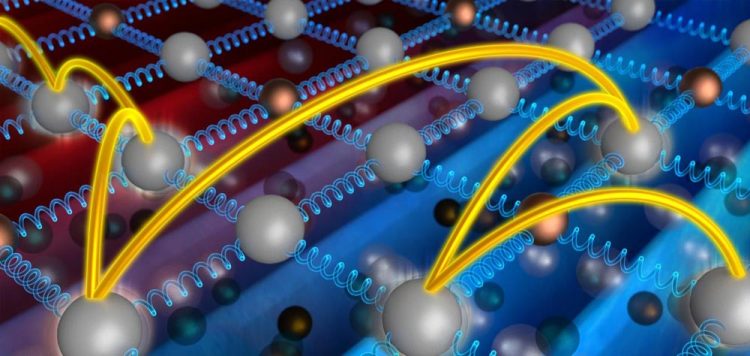New insights bolster Einstein's idea about how heat moves through solids

New research about the transfer of heat--fundamental to all materials--suggests that in thermal insulators, heat is conveyed by atomic vibrations and by random hopping of energy from atom to atom. This finding by Oak Ridge National Laboratory could introduce new materials as thermal energy barriers to drastically reduce energy costs, carbon emissions and waste heat. Credit: Jill Hemman and Adam Malin/Oak Ridge National Laboratory, US Dept. of Energy
The transfer of heat is fundamental to all materials. This new research, published in the journal Science, explored thermal insulators, which are materials that block transmission of heat.
“We saw evidence for what Einstein first proposed in 1911–that heat energy hops randomly from atom to atom in thermal insulators,” said Lucas Lindsay, materials theorist at ORNL. “The hopping is in addition to the normal heat flow through the collective vibration of atoms.”
The random energy hopping is not noticeable in materials that conduct heat well, like copper on the bottom of saucepans during cooking, but may be detectable in solids that are less able to transmit heat.
This observation advances understanding of heat conduction in thermal insulators and will aid the discovery of novel materials for applications from thermoelectrics that recover waste heat to barrier coatings that prevent transmission of heat.
Lindsay and his colleagues used sophisticated vibration-sensing tools to detect the motion of atoms and supercomputers to simulate the journey of heat through a simple thallium-based crystal. Their analysis revealed that the atomic vibrations in the crystal lattice were too sluggish to transmit much heat.
“Our predictions were two times lower than we observed from our experiments. We were initially baffled,” Lindsay said. “This led to the observation that another heat transfer mechanism must be at play.”
Knowing that the second heat transfer channel of random energy hopping exists will inform researchers on how to choose materials for heat management applications. This finding, if applied, could drastically reduce energy costs, carbon emissions and waste heat.
Many useful materials, such as silicon, have a chemically bonded latticework of atoms. Heat is usually carried through this lattice by atomic vibrations, or sound waves. These heat-bearing waves bump into each other, which slows the transfer of heat.
“The thallium-based material we studied has one of the lowest thermal conductivities of any crystal,” Lindsay said. “Much of the vibrating energy is confined to single atoms, and the energy then hops randomly through the crystal.”
“Both the sound waves and the heat-hopping mechanism first theorized by Einstein characterize a two-channel model, and not only in this material, but in several other materials that also demonstrate ultralow conductivity,” said ORNL materials scientist David Parker.
For now, heat-hopping may only be detectable in excellent thermal insulators. “However, this heat-hopping channel may well be present in other crystalline solids, creating a new lever for managing heat,” he said.
The study's lead coauthor was Saikat Mukhopadhyay, a former postdoctoral research associate at ORNL and currently a National Research Council research associate at the U.S. Naval Research Laboratory.
###
Additional coauthors of the paper titled, “Two-channel model for ultralow thermal conductivity of crystalline Tl3VSe4,” included ORNL's David S. Parker, Brian C. Sales, Alexander A. Puretzky, Michael A. McGuire and Lucas Lindsay.
This work was supported by the Department of Energy's Office of Science. Raman spectroscopy measurements were made at the Center for Nanophase Materials Sciences, and the study used computational resources from the National Energy Research Scientific Computing Center at DOE's Lawrence Berkeley National Laboratory. Both centers are DOE Office of Science User Facilities.
ORNL is managed by UT-Battelle for DOE's Office of Science. The Office of Science is the single largest supporter of basic research in the physical sciences in the United States, and is working to address some of the most pressing challenges of our time. For more information, please visit http://science.
Media Contact
All latest news from the category: Physics and Astronomy
This area deals with the fundamental laws and building blocks of nature and how they interact, the properties and the behavior of matter, and research into space and time and their structures.
innovations-report provides in-depth reports and articles on subjects such as astrophysics, laser technologies, nuclear, quantum, particle and solid-state physics, nanotechnologies, planetary research and findings (Mars, Venus) and developments related to the Hubble Telescope.
Newest articles

A ‘language’ for ML models to predict nanopore properties
A large number of 2D materials like graphene can have nanopores – small holes formed by missing atoms through which foreign substances can pass. The properties of these nanopores dictate many…

Clinically validated, wearable ultrasound patch
… for continuous blood pressure monitoring. A team of researchers at the University of California San Diego has developed a new and improved wearable ultrasound patch for continuous and noninvasive…

A new puzzle piece for string theory research
Dr. Ksenia Fedosova from the Cluster of Excellence Mathematics Münster, along with an international research team, has proven a conjecture in string theory that physicists had proposed regarding certain equations….



